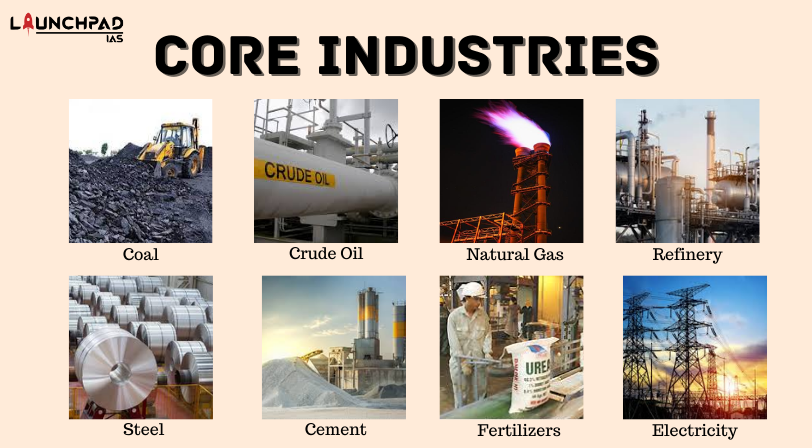The Core Industries of an economy are its primary or key industries. In India, there are eight sectors recognized as the core industries. This article provides detailed information about these eight core sectors of the Indian economy, relevant for the UPSC exam.
Eight Core Sectors
- Core Industries comprise 40.27% of the weight of items included in the Index of Industrial Production (IIP).
- The eight core sector industries in decreasing order of their weightage: Refinery Products> Electricity> Steel> Coal> Crude Oil> Natural Gas> Cement> Fertilizers.
- Coal: This sector includes activities related to the mining and production of coal. This is because coal is an essential source of energy for various industries.
- Crude Oil: This sector involves the exploration, extraction, refining, and production of crude oil. Crude oil is a vital raw material for the energy and petrochemical industries.
- Natural Gas: This sector deals with the extraction, processing, and distribution of natural gas. Natural gas is an important source of energy for power generation, heating, and industrial use.
- Refinery Products: This sector encompasses the production and refining of petroleum products. This includes petrol, diesel, liquefied petroleum gas (LPG), and aviation fuel.
- Fertilizers: This sector involves the manufacturing of fertilizers. Fertilizers are essential for agricultural productivity. They play a crucial role in ensuring food security.
- Steel: This sector includes activities related to the production of steel. Steel is a primary raw material for infrastructure development, construction, and manufacturing industries.
- Cement: This sector encompasses the production of cement. Cement is a key ingredient in the construction industry. It is used in the development of buildings, bridges, and infrastructure.
- Electricity: This sector involves the generation, transmission, and distribution of electrical power. Electrical power is essential for various sectors of the economy and overall economic growth.
Index of Industrial Production
- IIP is an indicator that measures the changes in the volume of production of industrial products during a given period.
- It is compiled and published monthly by the Central Statistical Organization (CSO), Ministry of Statistics and Programme Implementation.
- It is a composite indicator that measures the growth rate of industry groups classified under:
- Broad sectors, namely, Mining, Manufacturing, and Electricity.
- Use-based sectors, namely Basic Goods, Capital Goods, and Intermediate Goods.
- The base year for IIP is 2011-2012.
Significance of IIP
It is used by government agencies including the Ministry of Finance, the Reserve Bank of India, etc, for policy-making purposes.IIP remains extremely relevant for the calculation of the quarterly and advance GDP (Gross Domestic Product) estimates.
How is the Index Calculated?
The calculation of the ICI is done using the Laspeyres formula. This formula uses a weighted arithmetic mean of the quantity relatives to calculate the Index.
- The ICI is released with a one-month time lag for a reference month on the very last day of the following month.
- The base year for the ICI has been changed from its original base year of 2004-05 to 2011-12 under the new IIP series.
- The monthly and annual indices and growth rates are provided by Annex I & II, respectively.
- The monthly growth rate for each industry is calculated. It is computed by dividing the current month’s production quantity. The division is done by the base month’s quantity. The quotient is then multiplied by a hundred.
- The combined Index for Eight Core Industries for the current month is calculated. It is calculated as a weighted average of Production Relatives of industries. Laspeyre’s fixed-base formula is used.


